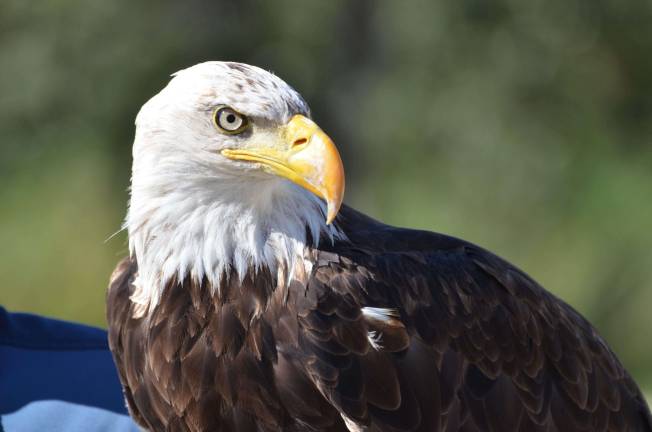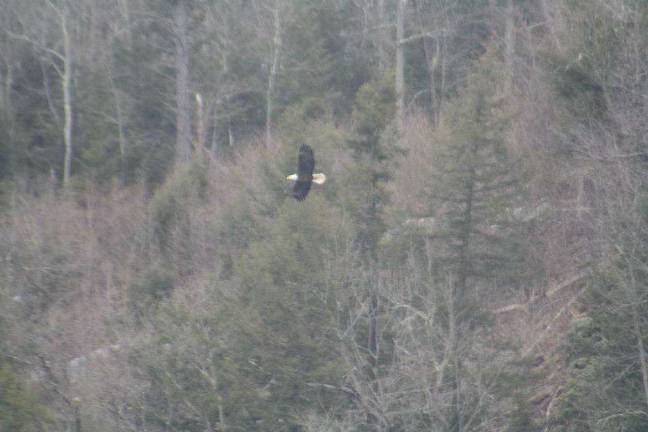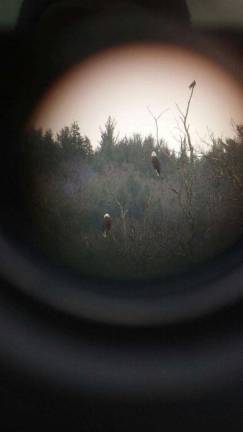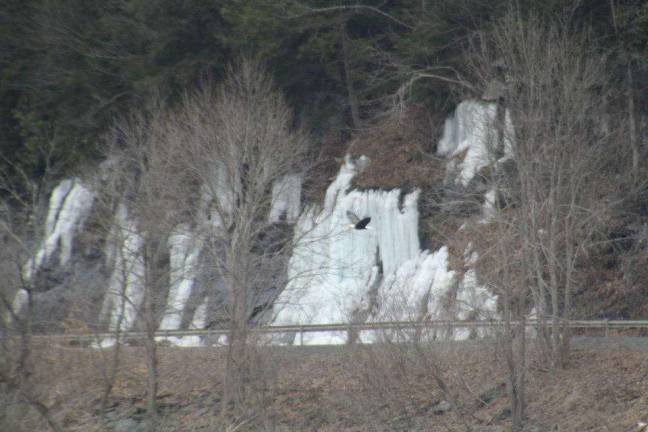Bald Eagle watching in Pike County




Despite a little chill in the air, there is something uplifting to look forward to help beat those winter blues.
The annual bald eagle migration takes place every year from January to March and the birds visit each year from as far away as Canada where they live year round, according to Nicole Slevin, Director of Communications at Cornell Cooperative Extension who also serves on the board of the Delaware Highlands Conservancy.
The birds have been the national emblem for the United States since 1782 and a spiritual symbol for native people here for far longer than that.
“They come down to the Delaware River to fish in the waters that do not freeze over the course of the winter due to the release of water by the power company on a regular basis,” said Slevin.
The eagles can fish in the running waters and roost in the abundant tall trees in the area.
Keeping track
A regular group of volunteer enthusiasts annually take part in an eagle count where they are given a form to fill out stating the time, number of eagles seen and area in which they were seen. As many as 30 people volunteer to do this and about 150 eagles are typically seen in any one migration.
On Jan. 11 and 12, nearly 20 participants under the guidance of volunteers helped collect data that was transferred to the National Mid-Winter bald eagle Survey orchestrated through the NYS Department of Environmental Conservation (DEC). The national survey is now being coordinated by the U.S. Army Corps of Engineers out of their San Francisco office, in partnership and with assistance from the previous coordinators at the Biological Resources Division of the U.S. Geological Survey.
The concern of tracking their numbers comes from the fact that in 1963 the number of nesting pairs had dwindled from as many as 100,000 nesting eagles in 1782 to near extinction at only 417 nesting pairs. They were listed on the Endangered Species List in 1973 and by 2007 the number grew to 9,789 nesting pairs in the contiguous United States enabling them to be removed from the list of threatened and endangered species.
They continue to be protected under the Bald and Golden Eagle Protection Act and the Migratory Bird Treaty Act. Both NYS DEC and Pennsylvania Game Commission have had bald eagle restoration or “hacking” programs in which young birds were imported from other states and hand reared to independence. The DEC now focuses on monitoring eagle activity and ensuring their survival continues.
“The bald eagle's recovery is a spectacular conservation success story. Partners in Flight estimates the global breeding population at 250,000, with 88 percent spending some part of the year in the U.S., 31 percent in Canada and 8 percent in Mexico,” said Slevin, adding that “regionally, the Upper Delaware River has played an important role in this population growth.”
Winter eagle watching
With proper technique and planning, winter eagle-watching has become a popular off-season activity in the Upper Delaware Valley.
According to the National Park Service, complex migration patterns of this bird of prey depend on age, breeding location and food availability. Northern adults begin fall migration when lakes and rivers freeze in northern areas. They usually migrate coast ward or to open water and return to their breeding grounds when weather and food permit, usually January to March.
Wintering eagles begin arriving in December with a concentration peaking in January and February. By mid-March most are heading back to their nests. It is this intensive monitoring and well-documented sightings that have helped determine New York's most popular eagle wintering habitats. While bald eagle sightings increase dramatically in winter months due to their migration patterns, “resident” eagle pairs nest in the area and are known to mate for life.
Bird spotting
The public is encouraged to view the bald eagles from a safe distance and at planned observation sites, two of which are maintained by the NYS DEC in the Mongaup Valley on the Rio and Mongaup Falls reservoirs (off NY Route 42). There is an information/observation booth at Mongaup Falls. The Delaware Highlands Conservancy office located on the Pennsylvania side of the Roebling Bridge offers maps, information and even bus tours of the eagle watch areas.
The bald eagle is distinguishable by its striking white head and tail and the 6 to 7 foot wingspan, however, it is not until an eagle reaches maturity at about five years that the white plumage develops. Younger, immature bald eagles are chocolate brown, mottled with white. For this reason, it is important to learn the size, shape and flying posture to correctly identify bald eagles, according to the DEC.
Not all eagle sightings need to be reported, but certain observations are helpful in managing and protecting eagles.
Report sightings
Anyone seeing eagles between April 15 and June 15, after the migration is encouraged to contact the DEC's Endangered Species Unit at 518-402-8924. It could lead to the discovery of new nesting pairs. Seeing four or more eagles in one location, especially after 3 p.m. could reveal a significant winter roost site.
The Delaware Highlands Conservancy, which merged with the Eagle Institute, works cooperatively with the NPS and with NYS DEC to help visitors find and properly observe wintering eagles along the Upper Delaware River. The Delaware Highland Conservancy can be reached at 570-226-3164 or info@delawarehighlands.org as a resource for more educational information on eagles and how to become more involved in eagle monitoring. CCE can be reached at 845-292-6180 or sullivan@cornell.edu for more information on local citizen science opportunities.